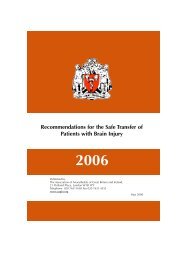TheatrePracticeStandardsGeneric1
You also want an ePaper? Increase the reach of your titles
YUMPU automatically turns print PDFs into web optimized ePapers that Google loves.
Generic Theatre Standard No 31 - The Management of Staff who are<br />
expectant and new mothers<br />
Standard Statement: Expectant Mothers (Staff) Working in the Perioperative Environment<br />
1. Duty of the Employee<br />
The Employee who is an expectant mother: as soon as is reasonably practicable, the<br />
employee has a duty to inform her line manager and the occupational health department.<br />
This must be confirmed in writing so that the line manager can make provision for maternity<br />
leave and arrange for a risk assessment to take place.<br />
2. Duty of the Employer<br />
• Theatre Manager has a responsibility to ensure that potential hazards are assessed by<br />
a risk assessment.<br />
• Ensure that all members of their staff have received information, instruction and<br />
training appropriate to their job responsibilities.<br />
• To ensure a planned service routine takes place for anaesthetic vaporizers and<br />
documentation to prove this is available.<br />
• Potential pollution from waste anaesthetic gases must be regularly monitored and<br />
documentation on results must be available.<br />
• Health and Safety Services: To provide advice and guidance to managers and<br />
individual employees on the health and safety aspects of hazards and risks associated<br />
with pregnancy and breastfeeding.<br />
• To liaise with managers across departmental boundaries in the provision of advice and<br />
guidance that may facilitate the resolution of any outstanding hazards/risks identified.<br />
• To monitor and audit the effectiveness of the policy and risk assessment system.<br />
• Occupational Health Department: To provide advice and guidance to employees<br />
on occupational health issues that they may encounter at work when a new,<br />
expectant or breast feeding mother.<br />
3. Anaesthetic Gasses<br />
• The highest levels of pollution in paediatric anaesthesia can occur at induction and on<br />
recovery but, with good air conditioning, the occupational exposure limit levels quickly<br />
return to normal.<br />
• Using a laryngeal mask airway in-patients undergoing ventilation is not necessarily<br />
associated with high concentrations of waste gases, providing the air conditioning is<br />
running at 20 air changes per hour<br />
• The Department of Health (NHS Executive 1996) published advice on the exposure<br />
standards for anaesthetic agents. In certain clinical settings (e.g. paediatric, ear, nose<br />
and throat procedures), and for the recovery practitioner working close to the patient,<br />
exposure levels will be higher. A risk assessment must be undertaken and may require<br />
that the expectant mother is removed from the clinical area, particularly in the first 12<br />
weeks of pregnancy.<br />
• The risks of leaks of anaesthetic agents must be minimised:<br />
o<br />
o<br />
Anaesthetic equipment should fit the patient correctly (e.g. face masks for<br />
children).<br />
Gases should only flow during anaesthesia, turned on at induction and turned<br />
off on completion of anaesthetic.<br />
96





